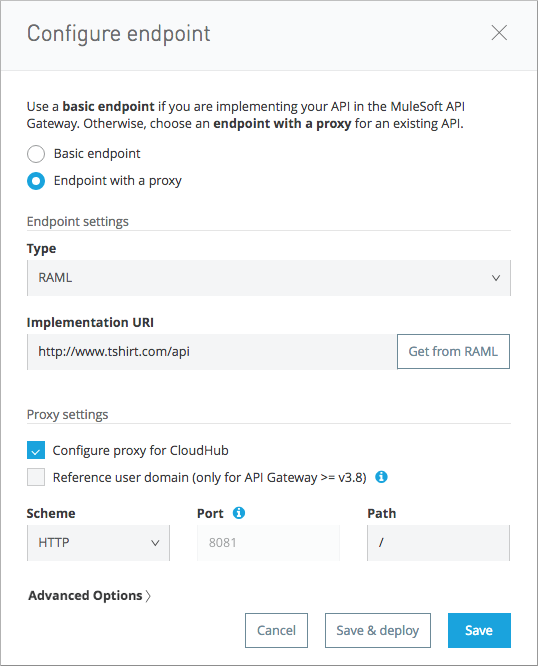
To Configure an Endpoint
Configure a basic endpoint if you create your API outside API Manager. For example, if you create the API using Mule Runtime, you don’t need a proxy.
If necessary, you can click Configure Endpoint at any time to make changes to the configuration. If you move your API, changing its inbound endpoint, reconfigure to set up a new proxy for the API based on its new URL.
In Status on the API version details page of an API, click Configure Endpoint. The following configuration sets up a proxy and deploys it to CloudHub.

-
Identify your API Type as either HTTP, WSDL, or RAML.
-
Select HTTP for non-RAML REST APIs, WSDL for SOAP APIs, or RAML if you API is based on RAML. Perform the next step depending on your choice:
-
HTTP: Provide the full URL of the inbound HTTP or HTTPS endpoint. Enter the address of the HTTP Listener of your deployed APIkit application in Implementation URI. The application can be running on-premises or on CloudHub. For example:
http://localhost:8086/apiorhttp://ab-tshirt-orders.cloudhub.io -
WSDL: Provide the source where Anypoint Platform can extract the URL. For example, you can set
http://myapiendpoint.comif your WSDL is available athttp://myapiendpoint.com?wsdl. -
RAML: Provide the baseUri from your RAML definition.
-
-
Enter the implementation URI, which is the baseUri in the RAML definition.
If you plan to deploy the API to production, provide the actual inbound URL of the API, not a placeholder URL; otherwise, to simulate calling the API, a placeholder is fine. In the latter case, you can replace the version with a {version} placeholder. For example, http://myapi.com/{version}/myresource/{version}
. If the API is deployed to a private server and you are using a load balancer, use your load balancer endpoint.



